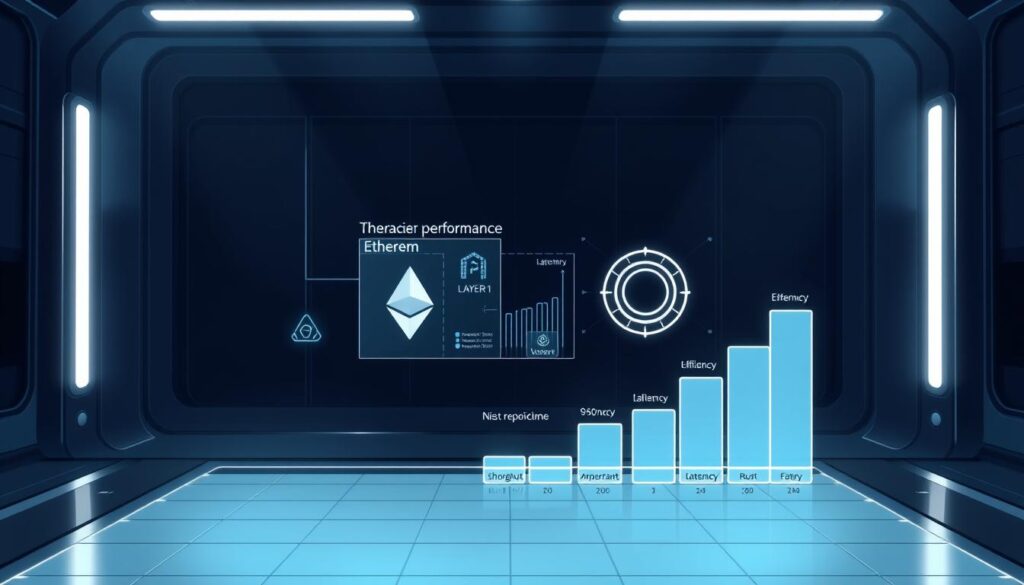The race to build dominant decentralized networks has reshaped how investors evaluate digital assets. For over a decade, developers have grappled with creating systems that balance speed, security, and accessibility—a puzzle that continues driving innovation across the industry. Emerging platforms now challenge established leaders by prioritizing specific advantages, from transaction throughput to energy efficiency.
This evolving landscape presents both opportunities and risks. New consensus mechanisms and network architectures aim to solve long-standing limitations, but adoption trends often lag behind technical breakthroughs. Investors must weigh proven ecosystems against experimental approaches promising radical improvements.
Market dynamics reveal a clear pattern: no single protocol currently dominates all use cases. While some networks excel at handling high-volume transactions, others prioritize robust security or developer-friendly environments. This fragmentation creates strategic choices for portfolio diversification.
Key Takeaways
- The core challenge for decentralized networks involves balancing speed, security, and accessibility
- Multiple protocols coexist by specializing in distinct technical advantages
- Investment decisions require evaluating tradeoffs between maturity and innovation
- Network architecture directly impacts long-term viability and adoption potential
- Portfolio strategies should account for shifting developer activity and user growth
Introduction to the Layer 1 Wars
Foundational challenges in digital infrastructure have sparked intense competition among protocol developers. Networks now face pressure to deliver faster transactions without compromising reliability or accessibility. This push for optimization has created a dynamic battleground where technical innovation directly impacts market value.
Understanding the Market Evolution
Early digital systems prioritized ironclad protection over speed, creating bottlenecks during peak usage. New entrants recognized this gap, designing architectures that handle thousands of transactions per second. These advancements attracted developers building applications requiring real-time responsiveness.
Market dynamics shifted as user demands grew more complex. Platforms offering flexible customization options gained traction alongside those focusing purely on speed. This diversification reflects the growing need for specialized solutions across industries.
The Role of Core Technical Challenges
At the heart of protocol design lies a critical balance act. “Enhancing transaction capacity often forces tradeoffs in system resilience or distributed control,” explains a leading network architect. This principle drives continuous experimentation with consensus methods and validation processes.
Developers now employ hybrid approaches combining multiple verification techniques. Some protocols split workloads across specialized chains, while others optimize data storage methods. These innovations demonstrate how technical constraints fuel creative problem-solving across the industry.
Defining the Comparison: Ethereum vs. Its Emerging Competitors

Decentralized platforms are diverging in their approaches to solving core technical challenges. Foundational systems now employ distinct strategies to balance speed, security, and accessibility—each claiming unique advantages for specific applications.
Architectural Choices Shape Capabilities
Transaction validation methods create stark contrasts between platforms. While some prioritize energy-efficient verification processes, others optimize for millisecond-level confirmation times. These design decisions directly impact:
- Operational costs for developers
- Finality guarantees for users
- Network upgrade flexibility
Throughput capacity varies dramatically across systems. Traditional models handle 7-15 actions per second, whereas redesigned architectures process thousands. This hundredfold difference determines which platforms can support real-time applications versus those better suited for high-value transfers.
Storage solutions further differentiate ecosystems. Some chains bundle transaction data with smart contract execution, while others separate these functions. This affects both developer experience and long-term maintenance costs.
“Network effects don’t guarantee technical superiority—they simply reflect early adoption advantages.”
Investment analysis requires examining both current metrics and upgrade roadmaps. Established systems benefit from robust tooling and developer communities, while newer entrants often showcase cutting-edge throughput capabilities. The market increasingly rewards specialized solutions tailored to specific use cases rather than one-size-fits-all approaches.
Deep Dive into Ethereum’s Core Features
Innovative protocol designs have redefined what decentralized systems can achieve through advanced technical frameworks. At the heart of this evolution lies a programmable environment enabling automated agreements and complex financial tools.
Smart Contracts and Proof of Stake Transition
The introduction of self-executing agreements revolutionized digital interactions by enabling trustless transactions. These programmable tools form the base layer for decentralized applications, from lending platforms to digital collectibles.
A landmark upgrade shifted validation from energy-intensive mining to stake-based participation. This overhaul slashed power consumption dramatically while maintaining robust security through economic incentives. Validators now commit resources to participate, aligning their interests with network integrity.
Network Security and Decentralization
Protection against malicious activity relies on substantial financial commitments from participants. Over $100 billion in locked value creates powerful disincentives for attacks, as compromising the system would devalue a validator’s own holdings.
Decentralization remains a priority, with thousands of independent operators maintaining the ledger. This distributed approach prevents single points of failure while ensuring no entity controls transaction verification. Diverse client software further strengthens resilience against potential exploits.
Exploring Solana’s High-Throughput Architecture

Next-generation networks prioritize raw performance through radical technical designs. One protocol achieves this by integrating timekeeping directly into its validation process, creating a synchronized system for processing actions at unprecedented scale.
This approach uses cryptographic timestamps to sequence events without requiring constant node communication. Validators reference this built-in clock to verify transactions rapidly, enabling confirmation times under a second. The design theoretically supports over 50,000 actions per second – enough to handle global-scale applications.
Innovative Consensus and Speed Advantages
The system combines two verification methods: a timestamp-based ordering protocol and an optimized Byzantine Fault Tolerance variant. This hybrid model reduces redundant data checks while maintaining network integrity. Developers praise its ability to slash fees for frequent microtransactions.
High-performance demands come with tradeoffs. Validators require enterprise-grade hardware – 12-core processors and 128GB RAM minimum. These specs create centralization pressures as fewer participants can afford the infrastructure. Network stability also suffers during traffic spikes, with multiple outages recorded since launch.
“You can’t have maximum speed and maximum decentralization simultaneously – physics won’t allow it.”
Despite these challenges, the architecture enables new financial tools and gaming platforms needing instant settlement. Investors monitor upgrade roadmaps addressing reliability while preserving throughput advantages. The balance between cutting-edge capability and operational stability remains critical for long-term adoption.
An Inside Look at Avalanche’s Multi-Chain Ecosystem
Specialized digital platforms are redefining scalability through compartmentalized architectures. By dividing operations across dedicated chains, these systems optimize performance while maintaining interoperability – a critical advantage for complex applications.
Three interconnected chains form the backbone of this approach. The X-Chain handles asset creation and trading, while the C-Chain executes smart contracts using Ethereum-compatible tools. The P-Chain coordinates validators and enables custom subnet development.
Parallel Processing and Subnet Functionality
This structure allows simultaneous transaction processing across chains. Unlike single-chain models, specialized networks don’t compete for resources. Developers can build:
- Financial instruments on separate subnets
- Enterprise solutions with custom rules
- High-frequency trading systems
| Feature | X-Chain | C-Chain | P-Chain |
|---|---|---|---|
| Function | Asset creation | Smart contracts | Network coordination |
| Consensus | Avalanche | Snowman | Snowman++ |
| Speed | 1.5s finality | 2s finality | Subnet-dependent |
Validators need only mid-tier hardware – 8-core processors and 16GB RAM. This lowers participation barriers compared to competitors requiring server-grade equipment. Faster transaction confirmation (1-2 seconds) comes from innovative consensus methods combining probabilistic and deterministic approaches.
“Subnets let organizations build purpose-specific networks without sacrificing ecosystem connectivity – it’s like having private highways connected to public roads.”
Investment potential stems from dual functionality: supporting decentralized apps while enabling enterprise solutions. This hybrid model attracts both developers and institutional users seeking tailored infrastructure.
Ethereum, Solana, Avalanche, Layer 1, blockchain trilemma
Decentralized systems face an inherent conflict between three vital attributes: speed, safety, and distributed control. Developers must prioritize certain features while accepting limitations elsewhere—a reality shaping investment decisions across digital networks.
Strategic Prioritization in Network Architecture
Established networks emphasize robust protection through large validator groups. This approach ensures tamper-resistant transactions but limits processing capacity during peak demand. High fees often result when many users compete for limited space.
Newer platforms take contrasting paths. Some achieve blazing speeds by centralizing validation power among few participants with advanced hardware. Others split workloads across specialized chains to maintain accessibility while improving throughput.
| Feature | Security-First | Speed-Optimized | Hybrid Model |
|---|---|---|---|
| Transactions/Second | 10-30 | 50,000+ | 4,500+ |
| Validator Requirements | Consumer Hardware | Server-Grade Systems | Mid-Tier Equipment |
| Finality Time | 6 Minutes | 1-2 Seconds |
Investment strategies should align with application needs. Financial institutions often prefer battle-tested systems for high-value transfers. Gaming and social platforms frequently choose networks offering instant confirmations despite centralized elements.
“The most successful protocols don’t try to win every race—they dominate specific lanes where their architecture excels.”
Upcoming upgrades aim to soften these compromises through sharding and advanced data compression. These innovations could redefine what’s possible while maintaining core principles of distributed systems.
The Importance of Layered Solutions in Blockchain Scaling
Scaling digital networks requires innovative approaches that build on existing foundations. Layered solutions offer a practical path forward by enhancing capabilities without overhauling core systems. These add-ons handle intensive tasks while maintaining strong security through their connection to base protocols.
Advancing Network Capabilities
Secondary frameworks process transactions off the main chain, freeing capacity for critical operations. Two primary methods dominate this space:
Optimistic validation accelerates processing by assuming transactions are legitimate. Challenges only occur if participants dispute activity within a set timeframe. This approach balances speed with accountability.
Cryptographic proof systems use advanced mathematics to verify thousands of actions instantly. These methods enable near-instant finality while maintaining rigorous security standards through encrypted verification.
Both techniques slash operational costs and congestion. Fees drop by up to 90% compared to base chain transactions, making microtransactions economically viable. Throughput reaches thousands of actions per second – enough for global applications.
Layered approaches demonstrate how ecosystems evolve through complementary systems rather than replacement. Developers gain flexibility to choose tools matching their needs while maintaining interoperability with established networks.
FAQ
What is the blockchain trilemma?
The blockchain trilemma refers to the challenge of balancing three critical factors: scalability, security, and decentralization. Platforms often prioritize one or two aspects, leading to trade-offs. For example, some networks optimize for speed but rely on fewer validators, while others emphasize decentralization at the cost of slower transactions.
How do Layer-1 solutions address scalability?
Layer-1 blockchains use advanced consensus mechanisms like Proof of Stake (PoS) or parallel processing to boost transaction throughput. Techniques such as sharding or subnet creation split workloads across chains, reducing congestion. These upgrades aim to handle high traffic without compromising data integrity or user costs.
Why are transaction fees lower on newer platforms compared to Ethereum?
Newer protocols often employ optimized architectures, such as high-throughput consensus models or modular designs, which process transactions faster and cheaper. While Ethereum’s fees rise during peak demand, competitors leverage streamlined infrastructure to minimize costs, attracting users seeking affordable services.
What role do subnets play in ecosystems like Avalanche?
Subnets are customizable chains within a network that let developers build specialized applications with unique rules. By isolating traffic and processing tasks in parallel, subnets reduce bottlenecks. This modular approach enhances scalability while maintaining interoperability across the ecosystem.
How does Proof of Stake improve blockchain efficiency?
Proof of Stake replaces energy-intensive mining with validator stakes, lowering energy costs and increasing transaction speed. Validators are incentivized to act honestly, as penalties apply for malicious behavior. This shift improves sustainability and enables faster finality compared to older consensus models.
What should investors consider when evaluating Layer-1 projects?
Key factors include transaction speed, network security, developer activity, and real-world adoption. Assess metrics like daily active users, governance structures, and partnerships. Diversifying across platforms with varying strengths—such as speed, fees, or decentralization—can mitigate risks in this competitive market.
Can Layer-2 solutions replace base-layer upgrades?
Layer-2 solutions like rollups or sidechains complement—not replace—base-layer improvements. They handle high-volume tasks off-chain while relying on the mainnet for security. However, long-term growth requires both Layer-1 upgrades and layered scaling strategies to meet evolving user demands.


